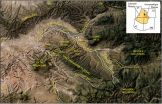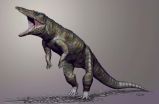The inner gorge originated ~300 million years ago, was buried, was then revealed about five million years ago when the ancestral Gunnison River began incising the Uncompaghre Plateau as part of the incision of the larger Colorado Plateau, and then the Gunnison River then abandoned the canyon upon landslide damming, ultimately joining the Colorado River.
This work highlights that incision of the Colorado Plateau by the Colorado River and its tributaries (including the Gunnison River) began synchronously across the entire Plateau, linking the incision of the Grand Canyon on the southern Plateau to events on the northern Plateau. It also highlights the intriguing possibility of preservation of very ancient landscapes from Earth's deep-time past, and the role of exhumation of those landscapes in shaping the modern face of the planet.
FEATURED ARTICLE Geology of Unaweep Canyon and its role in the drainage evolution of the northern Colorado Plateau
Gerilyn S. Soreghan et al., University of Oklahoma, Norman, Oklahoma 73019, USA. Published online 11 Mar. 2015; http://dx.doi.org/10.1130/GES01112.1. Themed issue: CRevolution 2: Origin and Evolution of the Colorado River System II.
Other GEOSPHERE articles (see below) cover such topics as 1. The 1989 Loma Prieta earthquake and the Santa Cruz Mountains;
2. The Bolivian orocline -- one of the largest, most recognizable examples of an actively deforming bent mountain chain on Earth;
3. Geometry and timing of faulting in the Rio Grande Rift; and
4. Gas venting and shallow subbottom gas hydrate occurrences.
All GEOSPHERE articles available at http://geosphere.gsapubs.org/. Representatives of the media may obtain complimentary copies of GEOSPHERE articles by contacting Kea Giles at the address above. Please discuss articles of interest with the authors before publishing stories on their work, and please make reference to GEOSPHERE in articles published. Non-media requests for articles may be directed to GSA Sales and Service, gsaservice@geosociety.org.
Comparison of 1989 Loma Prieta earthquake damage to mapped lineaments along the range front of the Santa Cruz Mountains, California
G.A. Phelps et al., U.S. Geological Survey, Menlo Park, California, USA. Published online 27 Feb. 2015; http://dx.doi.org/10.1130/GES01088.1. Themed issue: A New Three-Dimensional Look at the Geology, Geophysics, and Hydrology of the Santa Clara ("Silicon") Valley.
Hitchcock and Kelson (1994) mapped a series of lineaments (linear features of unspecified origin, generally distinguishable in aerial photographs) along the range front of the Santa Cruz Mountains near the town of Los Gatos. This paper tests whether or not damage recorded after the Loma Prieta Earthquake is located preferentially closer to the lineaments than a random scattering of damage. The damage turns out to be located near the lineaments, which supports the idea that the lineaments are related to fault activity.
Kinematic reconstruction of the Bolivian orocline http://Nathan Eichelberger, Princeton University, Princeton, New Jersey, USA; and Nadine McQuarrie, University of Pittsburgh, Pittsburgh, Pennsylvania, USA. Published online 11 Mar. 2015; http://dx.doi.org/10.1130/GES01064.1.
The curve in western side of South America is tectonically related to the change in orientation of the central Andes mountain chain between Peru and Bolivia. Referred to as the Bolivian orocline, it represents one of the largest, most recognizable examples of an actively deforming bent mountain chain on Earth. Piecing together how the Bolivian orocline formed reveals how the mechanics of curved mountain belts can influence the development of high elevation plateaus such as the Altiplano. This paper presents new map-view models that integrate geologic observations, rock cooling ages, and paleomagnetic data to reconstruct how the Bolivian orocline evolved from a relatively straight margin before 50 Ma to the curved geometry we see today. The models reveal that the magnitude of contraction accommodated in the crust during mountain building was greater than previous thought, giving rise to the extremely thick crust and high elevations observed at the Altiplano today.
Embryonic core complexes in narrow continental rifts: The importance of low-angle normal faults in the Rio Grande rift of central New Mexico http://Jason W. Ricketts et al., University of New Mexico, Albuquerque, New Mexico, USA. Published online 27 Feb. 2015; http://dx.doi.org/10.1130/GES01109.1.
The Rio Grande rift is one of the world's premier and best-studied continental rifts, although questions still remain regarding the timing and style of faulting in this region. This paper focuses on the geometry of faults and the timing of faulting in the Albuquerque basin of central New Mexico to understand how they evolved through time as rifting progressed. In the Albuquerque basin the average fault dip increases basinward, with shallowly dipping normal faults preserved along the rift flanks. Available timing constraints indicate that these shallow faults were active about 10 to 20 million years ago, and they were subsequently abandoned while steep faults emerged within the basin. These observations support a model where faults initiated at a steep dip along the flanks of the basin, and were shallowed during extension because of isostatic uplift. This model, which successfully predicts the geometries of faults in the Basin and Range, is now shown to be applicable to the modest extension Rio Grande rift, helping to bridge the gap between incipient extensional environments and highly extended regions.
Seafloor geomorphic manifestations of gas venting and shallow subbottom gas hydrate occurrences http://C.K. Paull et al., Monterey Bay Aquarium Research Institute, Moss Landing, California 95039-9644, USA. Published online 27 Feb. 2015; http://dx.doi.org/10.1130/GES01012.1.
A state of the art Autonomous Underwater Vehicle (AUV) was used to collect detailed bathymetry of areas surrounding nine deep-water gas vent sites along the Pacific margin of North America. The resolution that is achieved by the AUV surveys is equivalent to what can be done on land with flown LiDAR surveys and shows a characteristic rough morphology that has not been seen in this detail before. The rough morphology indicates the integrated effects of the enhanced biologic activity, seafloor deformation associated with gas hydrate formation and decomposition, and the addition of authigenic minerals.
A geophysical strategy for measuring the thickness of the critical zone developed over basalt lavas http://Johnathan R. Yaede et al., Brigham Young University, Provo, Utah, USA. Published online 11 Mar. 2015; http://dx.doi.org/10.1130/GES01142.1.
Studying the weathered zone of basaltic lavas can be challenging using conventional seismic exploration methods due to the gradational nature of the seismic velocity structure. We adapt a technique based on the dispersive properties of seismic surface waves to map the thickness and internal structure of the lateritic weathering profile (LWP) in Hawaiian basalts. Our results show good agreement with independent geologic constraints and indicate that the thickness of LWP correlates to climate variations across the island of Oahu. In this way, the rate of advance of the weathering front can be derived from seismic exploration without the need for drilling.
Great (?Mw8.0) megathrust earthquakes and the subduction of excess sediment and bathymetrically smooth seafloor
David W. Scholl et al., U.S. Geological Survey, Menlo Park, California 94025, and University of Alaska, Fairbanks, Alaska, USA. Published online 11 Mar. 2015; http://dx.doi.org/10.1130/GES01079.1. Themed issue: Exploring the Deep Sea and Beyond, Volume 2.
In the late 1980s, Larry Ruff conjectured that deep-sea trenches filled with sediment to more than about 1 km thick were prone to be the occurrence areas of great underwater earthquakes. The reason given was that the sediment smoothed the surface of earthquake slipping between the plate of the continental margin from that of the ocean plate sliding or subducting downward and landward beneath it -- thus the generation of large magnitude earthquakes. The observational data base then available to up hold this conjecture was not compellingly convincing. However, using a modern, much improved, and larger base of data a definitive statement can be made that the passage (i.e., subduction) of thick ocean floor sediment beneath the ocean margin statistically favors the rupturing of great subduction zone earthquakes -- and repeatedly so. Other factors, for example a subducting seafloor of low roughness, can also produce a smooth interface of sliding and favor the nucleation of great earthquakes.
Modern submarine canyon feeder-system and deep-sea fan growth in a tectonically active margin (northern Sicily)
Fabiano Gamberi et al., Istituto di Scienze Marine, Consiglio Nazionale delle Ricerche, Bologna, Italy. Published online 11 Mar. 2015; http://dx.doi.org/10.1130/GES01030.1. Themed issue: Exploring the Deep Sea and Beyond, Volume 2.
Existing models predict that specific facies assemblages alternate in the stratigraphy of deep-sea fans, depending on the cyclic nature of sea-level variations. Our work shows that turbidites, mass-transport deposits, and mixed fans are at present concurrently growing in the Sicilian offshore. We therefore demonstrate that models that predict changes in submarine fan facies on the basis of sea-level cycles do not necessarily apply to systems developed along tectonically active margins. In this case it is the degree of connection of canyon heads to coastal systems that determine the facies of deep-sea deposits. A further view that arises from our paper is that in active margins, the slope portion of fan systems, through seafloor instability and variations in channel gradient, is a key factor in determining the final deep-sea fan facies, regardless of the distance between the coast and the canyon.
The multiply deformed foreland fold-thrust belt of the Balkan orogen, northern Bulgaria
B.C. Burchfiel, Massachusetts Institute of Technology, Cambridge, Massachusetts, USA, and Radoslav Nakov, Bulgarian Academy of Sciences, Sofia, Bulgaria. Published online on 27 Feb. 2015; http://dx.doi.org/10.1130/GES01020.1.
ABSTRACT: The generally east-west-trending Balkan orogen (eastern Europe) consists of a northern belt of folded and thrusted Mesozoic and Cenozoic strata that forms the external fold-thrust belt of late Mesozoic and early Cenozoic age, and a southern belt that consists of deformed igneous and metamorphic rocks overprinted by Cenozoic extensional basins. Unlike most foreland fold-thrust belts, wherein deformation commonly migrates toward the foreland, the fold-thrust belt within the Balkan orogen is marginal to the Moesian Platform to the north, but was deformed in at least three events related to three different dynamic systems caused by changes in plate interactions. The earliest event of late-Early to early-Late Cretaceous deformed strata deposited within the Moesian continental margin and within a continental rifted belt containing deep-water flysch of Late Jurassic-Early Cretaceous age, a probable eastward extension of oceanic troughs from the Southern Carpathians. The shortening was a consequence of south or southwest synthetic subduction within the Vardar zone along the southern margin of the Balkan orogen. In Late Cretaceous time a backarc and/or intraarc rift zone developed along the southern margin of the fold belt, terminating shortening. The backarc and/or intraarc basin closed in Late Cretaceous-early Paleocene time, deforming the fold-thrust belt for a second time, but antithetically to north or northeast subduction in the Vardar zone. North- and northwest-vergent subduction within the Vardar zone caused magmatism, metamorphism, and deformation within the Rhodope area of southern Bulgaria south of the foreland thrust belt. In Paleogene time the southern part of the Balkan orogen became extensional with development of extensional basins and abundant magmatism due to trench rollback. The time of the final foreland fold-thrust belt deformation was late Eocene extending into Oligocene or early Miocene, contemporaneous with the extension to the south. The deformation within the fold-thrust belt was caused by a transfer of transpressional right shear within north Bulgaria and the Southern Carpathians as crustal units were translated northward west of the Moesian foreland crust and moved northeast and eastward into the eastern Carpathian west-dipping subduction zone. During the third event of deformation crustal units were molded around the Moesian foreland crust. The shortening ceased by early Miocene time and the right shear west of Moesian foreland crust was manifested by discrete right-slip faults to the present. During this third event southern Bulgaria was in an extensional regime that dominated the south- to southwest-vergent Hellenide orogen throughout the Cenozoic, thus dividing the Balkan orogen into two different deformational regions.
INFORMATION:
http://www.geosociety.org/


